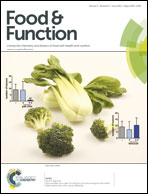Antitumor activity of the dietary diterpene carnosol against a panel of human cancer cell lines†
Abstract
Dietary phytochemicals found in vegetables and fruits consist of a wide variety of biologically active compounds with anti-carcinogenic activity. The aim of this study was to evaluate the antigrowth activity of carnosol, a dietary diterpene, as a single agent or in combination with other dietary phytochemicals or chemotherapeutic drugs against a panel of tumor cell lines. Carnosol decreased cell viability in human breast, ovarian, and intestinal tumor cell lines, and inhibited cancer cell adhesion on fibronectin and growth of cancer cells in suspension. Carnosol also inhibited EGF-induced epithelial mesenchymal transition in ovarian cancer cells. The combination treatment with other dietary phytochemicals increased the anti-proliferative activity of carnosol. The combination with curcumin resulted in a synergistic reduction of vitality in SKOV-3 and MDA-231 cells and potently inhibited viability of primary cancer cells isolated from the pleural fluid or ascites of patients with metastatic cancers. These results provide additional evidence about the anticancer role of carnosol and its potential in blocking the growth of tumor cells.


 Please wait while we load your content...
Please wait while we load your content...